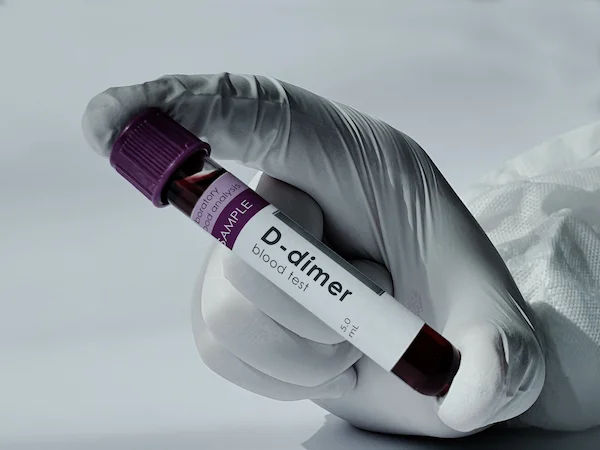How to Lower High D-Dimer Levels
Learn what high D-dimer levels mean, why they matter, and how to lower them through medical care, lifestyle changes, and preventive steps. Understand the symptoms, risks, and when to seek help.

Written by Dr. Siri Nallapu
Reviewed by Dr. D Bhanu Prakash MBBS, AFIH, Advanced certificate in critical care medicine, Fellowship in critical care medicine
Last updated on 24th Jul, 2025

If you’ve been told that your D-dimer levels are high, you might be feeling concerned or confused. Don’t worry—this article will help you understand what D-dimer is, why it matters, and what you can do to manage it effectively.
What is D-Dimer?
D-dimer is a small protein fragment that appears in your blood when a blood clot dissolves. It’s a natural part of your body’s healing process. However, high D-dimer levels can indicate that your body is forming and breaking down clots more than usual, which may signal an underlying health issue.
Why Do High D-Dimer Levels Matter?
Elevated D-dimer levels can be a sign of:
- Deep Vein Thrombosis (DVT): A blood clot in a deep vein, usually in the legs.
- Pulmonary Embolism (PE): A blood clot in the lungs.
- Disseminated Intravascular Coagulation (DIC): A serious condition where blood clots form throughout the body.
- Recent surgery or injury: The body naturally produces more clots during healing.
- Infections or inflammatory conditions: Such as COVID-19, pneumonia, or autoimmune diseases.
While a high D-dimer doesn’t always mean a dangerous condition, it’s important to consult a doctor to rule out serious problems.
Symptoms to Watch For
If your D-dimer is high due to a blood clot, you may experience:
- Swelling, pain, or redness in one leg (possible DVT).
- Sudden shortness of breath, chest pain, or coughing up blood (possible PE).
- Unexplained bruising or bleeding (possible DIC).
If you notice these symptoms, seek medical help immediately.
How to Lower High D-Dimer Levels
Since D-dimer is a marker of clotting activity, the best way to lower it is to address the underlying cause. Here are some ways to manage it:
1. Follow Your Doctor’s Treatment Plan
If a blood clot is detected, your doctor may prescribe:
- Anticoagulants (blood thinners): Such as warfarin, heparin, or direct oral anticoagulants (DOACs).
- Compression stockings: To improve blood flow in your legs.
- Clot-dissolving medications: In severe cases like PE.
Never stop or adjust medication without consulting your doctor.
2. Stay Active and Avoid Prolonged Sitting
- Move regularly: If you sit for long hours (e.g., desk job, travel), take short walks every hour.
- Exercise daily: Walking, swimming, or yoga helps circulation.
3. Hydrate Well
- Drink plenty of water: Dehydration thickens the blood, increasing clot risk.
- Limit alcohol & caffeine: These can dehydrate you.
Consult Top Hematologist For More Health Benefits
4. Eat a Heart-Healthy Diet
Foods that support circulation and reduce clotting risk:
- Omega-3 fatty acids: Found in fish (salmon, mackerel), flaxseeds, and walnuts.
- Garlic & turmeric: Natural blood thinners.
- Leafy greens (spinach, kale): Rich in vitamin K (but check with your doctor if on blood thinners).
- Berries & citrus fruits: High in antioxidants.
Avoid:
- Processed foods & excess salt: Can increase inflammation.
- Fried & fatty foods: May contribute to poor circulation.
5. Quit Smoking
- Smoking damages blood vessels and increases clotting risk. If you smoke, seek help to quit.
6. Manage Stress & Get Enough Sleep
- Chronic stress raises inflammation, which can affect clotting.
- Practice deep breathing, meditation, or gentle exercise.
- Aim for 7-8 hours of sleep per night.
7. Monitor Underlying Conditions
If you have diabetes, high blood pressure, or high cholesterol, managing these conditions helps lower D-dimer levels.
When to See a Doctor
If your D-dimer test is high but you have no symptoms, your doctor may recommend:
- Repeat testing: To check if levels normalize.
- Further tests: Ultrasound for DVT, CT scan for PE, or other blood tests.
Book a consultation if you:
- Have unexplained high D-dimer levels.
- Experience symptoms like leg pain or breathing difficulties.
- Need guidance on managing clotting risks.
Conclusion
High D-dimer levels can be concerning, but they’re often manageable with the right care. The key is to follow your doctor’s advice, stay active and hydrated, eat a balanced diet, and avoid smoking and excessive stress. With consistent effort and medical guidance, you can take control of your health and reduce clot-related risks.
If you need personalized advice, Apollo 24|7 offers expert consultations and lab tests to help you stay on top of your health.
Consult Top Hematologist For More Health Benefits
Consult Top Hematologist For More Health Benefits
Dr. Sudhanshu Bajaj
Anaesthesiologist
12 Years • MBBS, D.A
Ghaziabad
Medigyn Clinics, Ghaziabad

Dr. G Sakthi Vignesh
Anaesthesiologist
7 Years • MBBS , MD (Anaesthesiology),FPCI
Kanchipuram
Chettinad Hospital And Research Institute, Kanchipuram
Dr. Shaik Rasheed Ahmad
Anaesthesiologist
8 Years • MBBS , MD (Anesthesiology)
Tadepalligudem
Mother Vannini Hospital, Tadepalligudem
Dr. Vidyasagar Reddy
Anaesthesiologist
2 Years • MBBS , MD (Anesthesiology)
Bengaluru
Manipal Hospital,, Bengaluru

Dr. Mohit Dave
Pain Management Specialist
10 Years • MBBS, MD Anaesthesiology, Fellow ship in PainManagement.
Ahmedabad
Pain and Spine clinic, Ahmedabad
Consult Top Hematologist For More Health Benefits
Dr. Sudhanshu Bajaj
Anaesthesiologist
12 Years • MBBS, D.A
Ghaziabad
Medigyn Clinics, Ghaziabad

Dr. G Sakthi Vignesh
Anaesthesiologist
7 Years • MBBS , MD (Anaesthesiology),FPCI
Kanchipuram
Chettinad Hospital And Research Institute, Kanchipuram
Dr. Shaik Rasheed Ahmad
Anaesthesiologist
8 Years • MBBS , MD (Anesthesiology)
Tadepalligudem
Mother Vannini Hospital, Tadepalligudem
Dr. Vidyasagar Reddy
Anaesthesiologist
2 Years • MBBS , MD (Anesthesiology)
Bengaluru
Manipal Hospital,, Bengaluru

Dr. Mohit Dave
Pain Management Specialist
10 Years • MBBS, MD Anaesthesiology, Fellow ship in PainManagement.
Ahmedabad
Pain and Spine clinic, Ahmedabad




